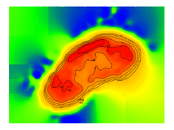Hi all
We're helping with a reef mapping project which is published on Wikitravel and titled "Diving the Cape Peninsula and False Bay"
I'd post the URL but SB won't let me as I am a bit of a noob here.
The other divers are swimming with surface markers fitted with GPS but we are using Mako scooters. Our GPS tracks are not as accurate a the swimmers' tracks but its usable.
My specific interest is not so much mapping exsisting reefs and wrecks but finding new ones and we've had some great success with that so far.
I've searched all over for quite some time but aside from a few posts on the Gavin Scooters list about which float from Riffe they use I have not found much about procedures for towing a surface marker with a scooter.
Obviously attaching the line to your person is not a good idea. Holding the reel in your left or right hand is possible (we scooter with the right hand) and I see that there's a Kent Tooling reel purpose made for scootering which might work well. Its kinda like a reel with a goodman handle attached.
What has worked quite nicely for us so far is a ratchet reel attached to the top of the scooter body. I'm using a bracket to attach the reel which I had made and was originally intended as a camera mount. Whats great about attaching the reel to the scooter is that:
- the line is in front of you where you can watch it and make sure that you avoid entanglement
- you don't have to hold onto the reel, so it frees up your hands
- if you keep the line under tension it stays well clear or the prop
- you can retrieve line with one hand because you don't have to hold onto the reel and wind with the other hand
We've "calibrated" the line with a permanent marker pen so you can judge the angle of the line (and therefore the distance) between the diver and the GPS on the surface. If you know your depth and how much line is reeled out it makes things simpler. Bear in mind that the viz here is often not so great. Last Sunday we scootered in viz which was only 5-6 meters.
The closer to 90 degrees the angle of the line, the more accurate the mapping and by implication there is less line in the water.
Just curious if anybody has any advice or tips or comments. Maybe somebody here has done something similar?
rgds
monty
We're helping with a reef mapping project which is published on Wikitravel and titled "Diving the Cape Peninsula and False Bay"
I'd post the URL but SB won't let me as I am a bit of a noob here.
The other divers are swimming with surface markers fitted with GPS but we are using Mako scooters. Our GPS tracks are not as accurate a the swimmers' tracks but its usable.
My specific interest is not so much mapping exsisting reefs and wrecks but finding new ones and we've had some great success with that so far.
I've searched all over for quite some time but aside from a few posts on the Gavin Scooters list about which float from Riffe they use I have not found much about procedures for towing a surface marker with a scooter.
Obviously attaching the line to your person is not a good idea. Holding the reel in your left or right hand is possible (we scooter with the right hand) and I see that there's a Kent Tooling reel purpose made for scootering which might work well. Its kinda like a reel with a goodman handle attached.
What has worked quite nicely for us so far is a ratchet reel attached to the top of the scooter body. I'm using a bracket to attach the reel which I had made and was originally intended as a camera mount. Whats great about attaching the reel to the scooter is that:
- the line is in front of you where you can watch it and make sure that you avoid entanglement
- you don't have to hold onto the reel, so it frees up your hands
- if you keep the line under tension it stays well clear or the prop
- you can retrieve line with one hand because you don't have to hold onto the reel and wind with the other hand
We've "calibrated" the line with a permanent marker pen so you can judge the angle of the line (and therefore the distance) between the diver and the GPS on the surface. If you know your depth and how much line is reeled out it makes things simpler. Bear in mind that the viz here is often not so great. Last Sunday we scootered in viz which was only 5-6 meters.
The closer to 90 degrees the angle of the line, the more accurate the mapping and by implication there is less line in the water.
Just curious if anybody has any advice or tips or comments. Maybe somebody here has done something similar?
rgds
monty





